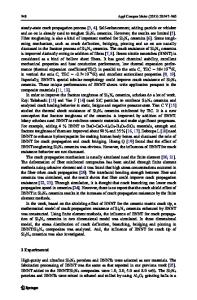Development of a new CuNiTiB brazing alloy for joining Si 3 N 4 to Si 3 N 4
- PDF / 702,360 Bytes
- 6 Pages / 612 x 792 pts (letter) Page_size
- 57 Downloads / 415 Views
I.
INTRODUCTION
Silicon nitride (Si3N4) ceramic is a kind of structural ceramic material with combinations of many superior properties and has been widely used in industry. However, it is difficult and expensive to manufacture ceramic components with large dimensions and complicated shapes. In addition, ceramic components with large dimensions are more likely to contain defects. Therefore, it is very important to obtain high-strength ceramic/ceramic or ceramic/metal joints both at room and high temperatures. Currently, the AgCuTi active brazing filler metal is commonly used in ceramic joining.[1,2] The bend strength of Si3N4/Si3N4 joints brazed with the AgCuTi alloy is about 400 to 450 MPa, both at room temperature and at 723 K.[3] But this brazing alloy contains a rather high quantity (up to 57 at. pct) of Ag, an expensive metal. The purpose of this article is to develop a new brazing alloy with similar properties to those of AgCuTi brazing alloy, but without silver and other expensive metals. Al-4Cu and Al-10Si brazing alloys have been developed for joining Si3N4/Si3N4, but the fracture shear strength of the joints reaches only 180 MPa at room temperature and decreases to about 32 MPa at 723 K.[4,5] The peak strength for the Cu-15Sn-15Ti alloy bonded to alumina is only 52 MPa.[6] But whether this is also the case for a silicon nitride ceramic is not yet clear. M. Naka et al.[7] used amorphous Cu-Ti alloys as a filler metal to join Si3N4/Si3N4, and the shear strength of joints brazed with a Cu66Ti34 alloy shows the maximum value of 313.8 MPa. The high-temperature shear strength of the joints brazed with Cu50Ti50 filler metal, which belongs to the same alloy system as Cu66Ti34, is not satisfactory (170 MPa at 723 K). We considered the possibility that adding Ni to the Cu-Ti filler metals would improve their mechanical properties. The wetting behavior of the CuNiTi alloys on Si3N4 has been reported.[8] This article investigates the joining of Si3N4/Si3N4 with the newly developed brazing alloy composed of Cu, Ni, Ti, and B. HUAPING XIONG, Doctor, and CHUANGENG WAN and ZHENFENG ZHOU, Professors, are with the Welding Division, Department of Materials Science and Engineering, Jilin University of Technology, 130025 Changchun City, People’s Republic of China. Manuscript submitted January 3, 1997. METALLURGICAL AND MATERIALS TRANSACTIONS A
II.
EXPERIMENTAL MATERIALS AND METHOD
The ceramic used is hot-pressed Si3N4 with additives of Y2O3, AIN, and Al2O3, which was supplied by the Shanghai Institute of Ceramics. The main phase of the ceramic is bSi3N4. The size of the Si3N4 bars to be joined is 3 3 4 3 20 mm. The purities of the Cu, Ni, Ti, and B powders are 99.7, 99.8, 99.0, and 97.1 wt pct, respectively, and the Cu34Ni27Ti39 brazing filler metal was prepared by double melting at 1533 K for 30 minutes in a resistance-heated vacuum furnace. The pressure of the furnace chamber was kept between 4.0 3 1023 and 6.7 3 1023 Pa during the melting. The filler metal was cut into 0.3-mm-thick foils by electric spark machining, an
Data Loading...











